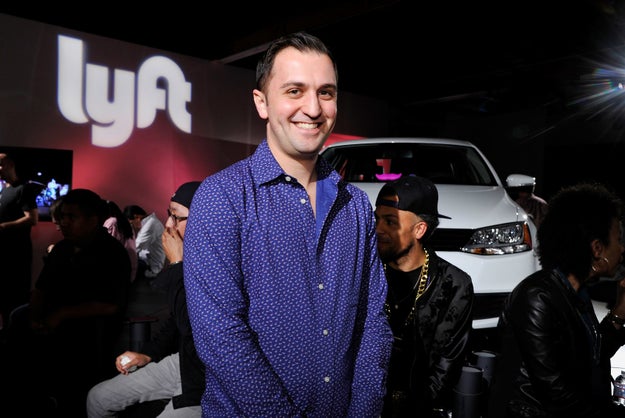
Lyft Co-founder John Zimmer
John Sciulli / Getty Images
As the calendar got ready to flip to 2017 this past Saturday, Lyft co-founder and president John Zimmer got behind the wheel of a white Chevrolet Equinox and turned on his app’s “Driver’s mode.” For four years running, Zimmer has taken a Lyft shift driving San Francisco’s revelers across town on New Year’s Eve. It was time to get back in action.
Lyft had a busy 2016. It started the year by raising $1 billion from a group led by General Motors, though that wasn’t enough to significantly cut into Uber’s almost $7 billion funding lead. Later, it was rumored to be for sale, but said it was instead approached by potential buyers it turned down. And its role as a network connecting cars and passengers became more intriguing with the emergence of automated driving, a development that could make Lyft emerge as the software directing these robot-driven cars to pickups and dropoffs, and will likely bring along more competitors.
I was Zimmer’s first pickup of the night, as I had been a year prior, giving us plenty to catch up on. Almost as soon I uttered my first question, Zimmer got a pickup request, and we were off to the races.
Automated Future

Lyft
When Zimmer told his second pickup of the night, Miranda, that her ride was free, she celebrated by asking him to play Shaggy on the car’s speakers. Zimmer obliged, and when “Angel” came on, the already festive mood turned really festive.
You can tell Zimmer enjoys giving these rides, which is ironic, given that his company’s future may not include human drivers. At the start of 2016, autonomous vehicles were still abstract; much hyped but little used in the real world. By the end of the year, autonomous driving became much more real when Uber’s self-driving cars hit the streets of Pittsburgh and San Francisco (at least temporarily), and the company’s autonomous truck made its first delivery.
Lyft is getting in on the self-driving action too. This year, it plans to introduce autonomous driving cars along some fixed routes, according to a blog post Zimmer penned in September. And within five years, Lyft expects that a fleet of autonomous cars will handle the majority of its rides in the US.
But Zimmer cautioned me not to relegate Lyft’s 700,000 or so human drivers to the unemployment line just yet. There should still be work for them when the cars drive themselves, he explained. “In my mind these automated vehicles are more like rooms on wheels,” Zimmer said. “It could be a social experience, it could be a movie theatre on wheels, it could be a bar on wheels. There will be people that we need to provide those services.”
In the near term, Zimmer said, Lyft is still trying to recruit more human drivers. Today, only a minuscule percentage of miles traveled in the US are in Lyfts and Ubers, Zimmer said, and if his company can convince people to ditch their cars in favor of ride hailing, it could create more work for drivers, even if some of the routes are driven by robots.
What of Zimmer’s New Year’s Eve driving ritual though? “I enjoy it. It’s fun,” he told me. But in a few years? “Maybe then I’ll be your bartender.”
The Manufacturers Cometh

Lyft
After dropping off Miranda, Zimmer picked up a new passenger, Matthew, and began driving down the 101 highway towards San Francisco’s Tenderloin district. The road ahead was clear, but it was hardly a metaphor for the competition and challenges Lyft is facing.
Five months ago, Tesla CEO Elon Musk unveiled a ‘master plan’ for his company that teased the idea of turning self-driving Teslas into part time ride-hailing vehicles, which would put the car manufacturer squarely in competition with Lyft and Uber. Tesla isn’t the only car manufacturer going down this path. Last August, Ford said it too would develop autonomous vehicles and use them for ride hailing. Toyota, BMW, and other manufacturers have also expressed plans to develop self-driving cars.
Car manufacturers’ entry into ride hailing would pose major threats to Lyft: They can gain access to vehicles at a cheaper cost by producing them on their own, and in many cases they have relationships with customers that run deeper than the nascent ride hailing companies.
This doesn’t mean Lyft is toast. When autonomous cars go mainstream, Zimmer explained, there will be three components to the business: the cars themselves, the self-driving technology, and the networks they run on, like Uber and Lyft. Zimmer argued that the networks, which manage the movement of cars and relationships with customers, will be the most important of the three, noting that Lyft and Uber have a head start over new competitors.
“We know where the passengers are and where the demand is going,” Zimmer said. Lyft, he argued, could serve more people with fewer cars than newcomers because it knows where to position the cars to efficiently meet the demand. The long play for Lyft, Zimmer said, is to get people to give up car ownership in favor of Lyft subscriptions where they'd buy miles just like they buy minutes from cell providers. Autonomous cars could help take this from an unreasonable expense to a cheap enough alternative that it would demand serious consideration.
Show Me The Money, Johnny

Lyft
Zimmer’s final pickup was Siaga, an American Airlines flight crew member in town for New Year’s who needed to get to H&M for an emergency New Year’s outfit. Siaga could splurge a bit since his ride was on Zimmer, placing him in a growing group of people who have had their rides subsidized by Lyft.
Lyft, according to Bloomberg, has promised investors to keep its losses below $150 million per quarter. And in December, a Bloomberg report stated that although Uber would make more than $5.5 billion in net revenue in 2016, it could lose $3 billion in the process. These reports led some to question whether ride hailing companies were real businesses, so I asked Zimmer if they were. He responded affirmatively.
“On a per-ride basis, rides are profitable,” Zimmer explained. The losses, he said, come from trying to win over new passengers (you may have seen people handing out $50 Lyft credits on a street near you — this is part of that effort). “Having a certain amount of scale is the early part of the business, but doing 17 million+ rides every month will lead us to a profitable business.” Lyft, he said, has tripled its number of rides since we met last year.
So when will Lyft be profitable? Zimmer wouldn’t say. But he said the company has a plan to use less money than it’s raised to get to profitability. “When you look at the unit economics per ride, there is a comfortable margin there that will allow us to cover all our expenses and become profitable.”
With that, it was my turn to be dropped off. Seems like Lyft is in good shape to be around next New Year's Eve too, so we’ll pick this up then.
from BuzzFeed - Tech https://www.buzzfeed.com/alexkantrowitz/lyft-co-founder-john-zimmer-interview-automation?utm_term=4ldqpia
No comments:
Post a Comment